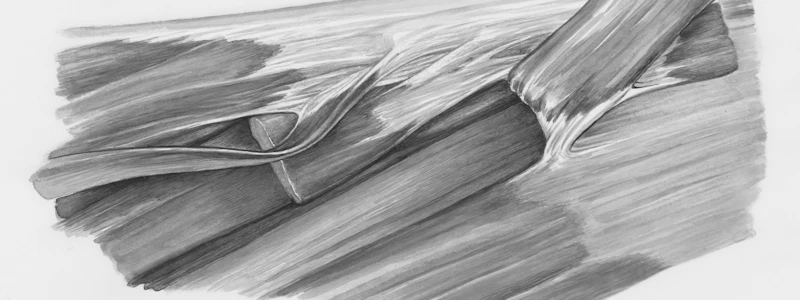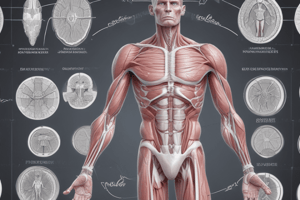Podcast
Questions and Answers
What characteristic property allows smooth muscle fibers to gradually drift towards action potential?
What characteristic property allows smooth muscle fibers to gradually drift towards action potential?
- Neuro-muscular junction activity
- Pacemaker activity (correct)
- Repolarization activity
- Independent innervation
Which type of smooth muscle fibers are independent and not connected by gap junctions?
Which type of smooth muscle fibers are independent and not connected by gap junctions?
- Single unit fibers
- Multi-unit fibers (correct)
- Skeletal fibers
- Cardiac fibers
What is the primary role of calcium ions in muscle contraction for smooth muscle?
What is the primary role of calcium ions in muscle contraction for smooth muscle?
- To regulate thin filaments
- To activate the autonomic nervous system
- To enable cross bridge formation with thick filament (correct)
- To initiate action potentials
Where are single unit smooth muscle fibers primarily found?
Where are single unit smooth muscle fibers primarily found?
What mechanism primarily drives smooth muscle contraction?
What mechanism primarily drives smooth muscle contraction?
How do single unit smooth muscle fibers react to the depolarization of one fiber?
How do single unit smooth muscle fibers react to the depolarization of one fiber?
What type of muscle is smooth muscle categorized as?
What type of muscle is smooth muscle categorized as?
Which muscle type is primarily associated with the heart wall?
Which muscle type is primarily associated with the heart wall?
What distinguishes multi-unit smooth muscle fibers in terms of contraction from single unit fibers?
What distinguishes multi-unit smooth muscle fibers in terms of contraction from single unit fibers?
Which location is NOT typically associated with multi-unit smooth muscle fibers?
Which location is NOT typically associated with multi-unit smooth muscle fibers?
What role does the myosin light chain kinase play in smooth muscle contraction?
What role does the myosin light chain kinase play in smooth muscle contraction?
Which of the following mechanisms does NOT initiate smooth muscle contraction?
Which of the following mechanisms does NOT initiate smooth muscle contraction?
What percentage of ATP does smooth muscle use compared to skeletal muscle for the same contractions?
What percentage of ATP does smooth muscle use compared to skeletal muscle for the same contractions?
What type of activation does NOT occur in smooth muscle for contraction?
What type of activation does NOT occur in smooth muscle for contraction?
Which statement correctly describes the characteristic structure of smooth muscle?
Which statement correctly describes the characteristic structure of smooth muscle?
Which of the following channels allows calcium to enter smooth muscle cells primarily through mechanical stimulation?
Which of the following channels allows calcium to enter smooth muscle cells primarily through mechanical stimulation?
Which term describes smooth muscle that contracts as a single unit?
Which term describes smooth muscle that contracts as a single unit?
What is the primary role of calcium ions (Ca++) in smooth muscle contraction?
What is the primary role of calcium ions (Ca++) in smooth muscle contraction?
What distinguishes spontaneous electrical activity in smooth muscle?
What distinguishes spontaneous electrical activity in smooth muscle?
How does smooth muscle differ from skeletal muscle in terms of ATP utilization?
How does smooth muscle differ from skeletal muscle in terms of ATP utilization?
Flashcards
Pacemaker Activity
Pacemaker Activity
The property exhibited by certain smooth muscle fibers where their membrane potential gradually drifts towards threshold, triggering action potentials and causing rhythmic contractions. This is often observed in the GI tract.
Multi-Unit Smooth Muscle
Multi-Unit Smooth Muscle
A type of smooth muscle where fibers are independently innervated and not connected by gap junctions. Contraction occurs only in the stimulated fiber, not in the entire bundle.
Single-Unit Smooth Muscle
Single-Unit Smooth Muscle
A type of smooth muscle where fibers are connected by gap junctions, allowing synchronous depolarization and contraction throughout the bundle. Stretching of one fiber triggers a coordinated response in the entire unit.
Neuro-muscular Junction
Neuro-muscular Junction
Signup and view all the flashcards
Varicosities
Varicosities
Signup and view all the flashcards
Muscle Contraction
Muscle Contraction
Signup and view all the flashcards
Myosin
Myosin
Signup and view all the flashcards
Actin
Actin
Signup and view all the flashcards
ATP
ATP
Signup and view all the flashcards
Neurotransmitter
Neurotransmitter
Signup and view all the flashcards
Smooth Muscle
Smooth Muscle
Signup and view all the flashcards
Myosin Structure in Smooth Muscle
Myosin Structure in Smooth Muscle
Signup and view all the flashcards
Smooth Muscle Membrane Activation
Smooth Muscle Membrane Activation
Signup and view all the flashcards
Smooth Muscle Contraction Initiation by Membrane Potential Changes
Smooth Muscle Contraction Initiation by Membrane Potential Changes
Signup and view all the flashcards
Spontaneous Pacemaker Activity in Smooth Muscle
Spontaneous Pacemaker Activity in Smooth Muscle
Signup and view all the flashcards
Calcium Regulation of Myosin Light Chain Kinase
Calcium Regulation of Myosin Light Chain Kinase
Signup and view all the flashcards
Smooth Muscle Contraction Efficiency
Smooth Muscle Contraction Efficiency
Signup and view all the flashcards
Tension Variability in Smooth Muscle
Tension Variability in Smooth Muscle
Signup and view all the flashcards
Study Notes
Smooth Muscle Overview
- Smooth muscle is an involuntary, non-striated muscle type found in blood vessels and internal organs.
- Cardiac muscle is involuntary, striated, and forms the heart wall.
Learning Objectives
- Describe the structure and function of smooth muscle types.
- Explain how smooth muscle myofilaments are regulated.
- Name three ways in which smooth muscle contraction is initiated.
- Explain spontaneous electrical activity (pacemaker) in smooth muscle.
- Contrast single unit and multiunit smooth muscles.
Smooth Muscle Structure
- Smooth muscle cells are spindle-shaped with a single nucleus.
- They have thin filaments (actin) and thick filaments (myosin).
- Intermediate filament bundles are attached to dense bodies.
- Caveoli are present in the plasma membrane.
Smooth Muscle Myofilament Regulation
- Myosin has two subunits: a heavy chain (containing ATPase activity) and a light chain (regulating ATPase).
- Myosin light chain kinase (MLCK) is activated by Ca++.
- Phosphorylation by MLCK allows cross-bridge formation between myosin and actin, initiating contraction.
Smooth Muscle Contraction Initiation
- Three primary ways:
- Autonomic nervous system (parasympathetic, sympathetic, and enteric) via voltage-gated Ca++ channels.
- Hormones via ligand-gated Ca++ channels.
- Stretch via mechano-gated Ca++ channels.
Pacemaker Activity
- Some smooth muscle exhibits spontaneous contractile activity without nerve or hormonal stimulation.
- The resting membrane potential gradually drifts toward threshold, triggering action potentials.
- Following repolarization, the membrane depolarizes again. This spontaneous activity is called pacemaker activity.
- Common in the GI tract.
Single-unit vs. Multi-unit Smooth Muscle
- Single-unit smooth muscle:
- Cells are connected by gap junctions, allowing synchronized depolarization and contraction.
- Often found in the walls of internal organs (e.g., intestines, blood vessels) and the uterus.
- Stretching one cell can initiate a coordinated contraction in the entire sheet.
- Multi-unit smooth muscle:
- Fibers are innervated independently.
- Depolarization of one fiber triggers contraction only of that fiber.
- Located in areas requiring fine control, like large arteries, airways, and hair follicles.
- Autonomic nerves and hormones regulate contraction; not stretch.
Membrane Activation
- Smooth muscle contraction depends on a rise in cytosolic calcium.
- Calcium enters the cytoplasm through calcium channels (voltage-gated, ligand-gated, and mechano-gated).
- Smooth muscle lacks t-tubules.
Characteristics of Smooth Muscle
- Smooth muscle contractions are slow and sustained using less ATP than skeletal muscle.
- Smooth muscle exhibits variability in tension.
Relaxation of Smooth Muscle
- Relaxation is achieved by removing calcium from the cytoplasm.
Studying That Suits You
Use AI to generate personalized quizzes and flashcards to suit your learning preferences.




